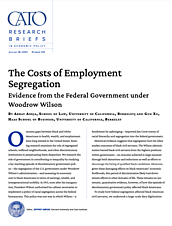Outcome gaps between black and white Americans in health, wealth, and employment have long existed in the United States. Existing research examines the role of segregated schools, redlined neighborhoods, and other discriminatory institutions in perpetuating these disparities. We research the role of government in contributing to inequality by studying a far-reaching episode of discriminatory government policy—the segregation of the U.S. government under Woodrow Wilson’s administration—and assessing its economic cost to black Americans in terms of earnings, wealth, and intergenerational mobility. In 1913, soon after his inauguration, President Wilson authorized his cabinet secretaries to implement a policy of racial segregation across the federal bureaucracy. This policy was one way in which Wilson—a Southerner by upbringing—imported Jim Crow norms of racial hierarchy and segregation into the federal government.
Historical evidence suggests that segregation hurt the labor market outcomes of black civil servants. The Wilson administration barred black civil servants from the highest positions within government—an outcome achieved in large measure through both demotions and reductions as well as efforts to discourage the hiring of qualified black candidates. Moreover, given these damaging effects on black Americans’ economic livelihoods, this period of discrimination likely had downstream effects in other domains of life. There remains no systematic, quantitative evidence, however, of how this episode of discriminatory government policy affected black Americans.
To study how federal segregation affected black American civil servants, we undertook a large-scale data digitization effort, digitizing government personnel records covering the careers of over 1.3 million federal employees. Namely, we digitized volumes of the Official Register of the United States, a biennial government publication that provided a detailed list of all employees of the federal government and their salaries. Moreover, to identify a federal employee’s race, we also link our newly digitized administrative records to the complete count decennial censuses.
We then use this uniquely rich, high-frequency data source to quantify the effect of federal segregation. We compare each black civil servant with a white counterpart who—at the onset of Wilson’s presidency—was of the same sex and comparable age, worked in the same cabinet office, and earned a similar salary for a similar job. We assess how the black-white earnings gap changed after Wilson’s 1913 segregation policy took effect.
Our main finding is that President Wilson’s segregation policy had persistently negative consequences for black civil servants. Using our matched set of comparable black and white civil servants, we find black civil servants earned approximately 3.4–6.9 percentage points less over the duration of Wilson’s presidency. The effect of Wilson’s segregation policy was most pronounced within the Navy Department, the Post Office, and the Treasury Department—departments known for having implemented the segregation order earliest and most aggressively at the behest of the president.
In terms of channels underlying our main finding, we document evidence suggesting that federal segregation adversely affected black civil servants’ labor market outcomes chiefly through the reallocation of black civil servants to lower-salaried positions. We also find that segregation led some to leave government employment entirely, shutting down opportunities for economic advancement. Similarly, we show that black entrants to the civil service entered at lower salary levels after Wilson took office and that there was increased exit among higher-earning black civil servants under Wilson.
Finally, we consider whether the sizable and pernicious consequences of federal segregation extended beyond the adverse effects on earnings of black civil servants during Wilson’s term. First, we analyze whether the earnings losses incurred due to state-sponsored discrimination within the federal government affected long-term wealth accumulation. We do so by using decennial censuses from 1900 to 1940 to study the racial gap in home ownership around Wilson’s term. We find that the same black civil servants victimized by discrimination in federal employment were also less likely to own a home in 1920, 1930, and 1940, almost three decades after Wilson was elected. Moreover, using the 1940 decennial census, we document that the school-age children of black civil servants who served in the Wilson administration went on to have lives of poorer quality than those of their young white counterparts in terms of their overall earnings and quality of employment in adulthood. We use census data to compare the 1940 outcomes of children of black and white civil servants—by exploiting variation in the age of the children at the onset of the segregation policy in 1913, we compare children who were young enough to be living with their civil service parents exposed to the segregation order with those who were old enough to not be living with their civil service parents.
To ensure that the results are not driven by other trends, we compare the outcomes of civil servants’ children to those of private-sector workers’ children, who were not directly affected by the federal segregation policy. While racial outcome gaps had remained relatively constant between old and young children of private-sector workers, the same outcome gap increased for children of federal civil servants. Twenty years after Wilson left office, young black children of civil servants report lower levels of education, lower earnings, and a decline of 9 percentiles in the overall income-distribution rank. These results thus provide suggestive evidence that the effects of Wilson’s segregation policy adversely affected intergenerational income mobility.
Note
This research brief is based on Abhay Aneja and Guo Xu, “The Costs of Employment Segregation: Evidence from the Federal Government under Woodrow Wilson,” Quarterly Journal of Economics 137, no. 2 (May 2022): 911–58.

This work is licensed under a Creative Commons Attribution-NonCommercial-ShareAlike 4.0 International License.
